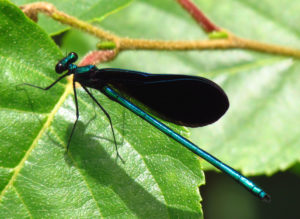As I looked out the window on a recent calm morning, I saw that the lilac bush outside was covered in delicate strands of spider silk. They waved and gleamed in the early morning sunshine, and I thought of the untold number of little spiderlings moving from one place to another before reaching adulthood. Young spiders often release a strand of silk from their abdomens which is is caught up by the wind, carrying the little beasties to new places. They call it ballooning, and it is an effective and efficient way of traveling, even at great heights.
As our seasons progress, we pass through times when different animals and plants are most noticeable – the time of sleeping trees in winter, the time of birds in the spring, the time of insects (and spiders) in mid-late summer, and the time of trees in the fall. Wildflowers of different species are present throughout the warm months and give us a carpet accessorized by the others.
Insects and spiders should not be the subjects of fear or disgust, overall. For every annoying mosquito or black fly there is a pollinator helping to feed us. For every creepy tick there is an amazing butterfly. And of course, we should take precautions to prevent diseases transmitted by certain insects/ticks and not do things that encourage spiders to bite, but these hazards have been with us as long as people and invertebrates have lived together. Even though I am often being bitten in the process, I still think that watching fireflies in mid-summer is magical. And this appears to be an exceptional year for fireflies.
A friend of Woodland Dunes called the nature center the other day to say that she missed watching dragonflies at a site where a pond was long ago filled in. The dragonflies and their relatives are truly remarkable. I am not an expert, but I appreciate the many colorful species of dragonflies, damselflies, pondhawks, meadowhawks, skimmers, clubtails – they are such a challenge to identify especially on the fly. My favorite is the ebony jewelwing, which lives around small rivers and streams. To me, they are a work of art.
As usual, birds have taken center stage so far this season when it comes to singing, but soon insects will begin to join them: cicadas, grasshoppers, crickets – they will more than fill the void when the birds go silent. Silently accompanying them are the thousands of species of butterflies and moths, in forms too numerous to mention.
It is difficult to think how vast and complicated nature is, and how many parts (species) it takes to make it work. People oversimplify nature, and sometimes try to reduce it to what they perceive as useable. To do so is a mistake. Like birds and other wildlife, insects are facing a slow decline in population in many places, probably due to our activities. At our preserve, we do what we can to protect native wildlife – lets hope we are more thoughtful on a larger scale as well.
photo- ebony jewelwing damselfly from wikipedia

